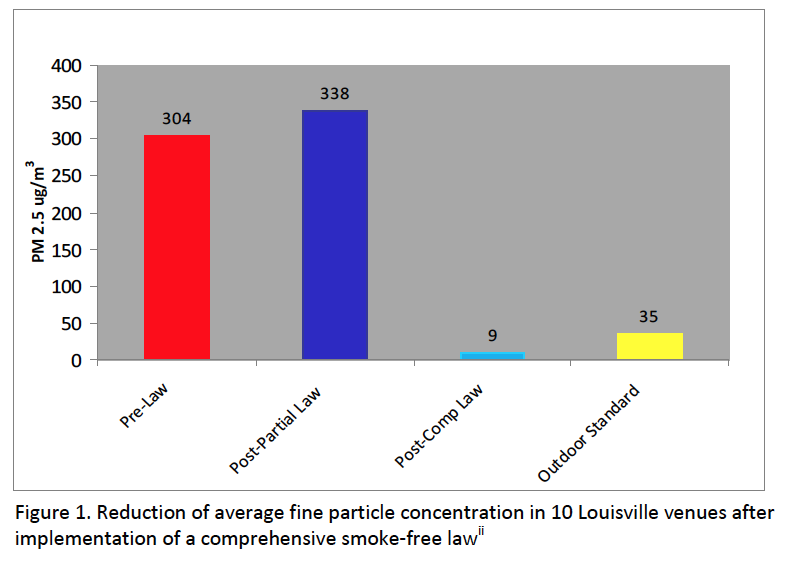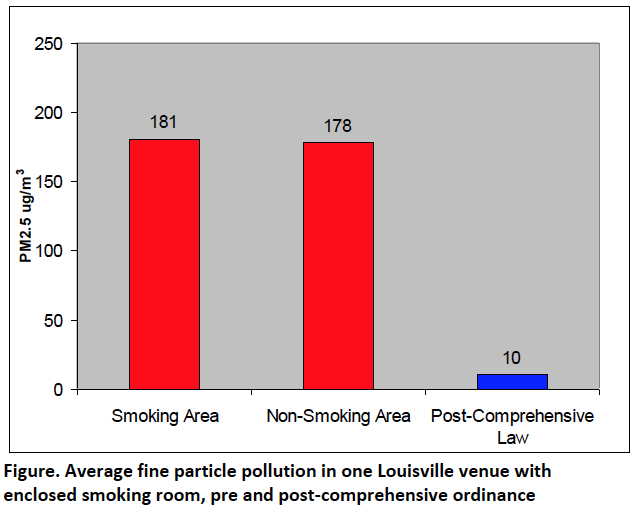Click here to download the PDF version.
The Potential Effect of Partial Smoke-free Laws on Indoor Air Quality
- There is no safe level of exposure to secondhand smoke.i Comprehensive smoke-free laws that cover all workplaces and all public places with no exemptions protect all workers and members of the public from the toxic poisons in secondhand smoke.
- Exemptions are often proposed by opponents to smoke-free laws with the overt intent of compromise. In reality, exemptions create confusion and enforcement challenges, an unlevel playing field for businesses, potential for legal challenges, and they leave workers unprotected from the hazards of secondhand smoke.
- As an enforcement official in Louisville said, “…the governing body should plan for a future re-write if they allow exemptions. Go ahead and bite the bullet now for the sake of public and employee health.”
Exemptions are problematic because they:
1) Create Confusion and Make Enforcement a Challenge
2) Create an Uneven Playing Field: Business Owners Say that is Not Fair
3 )Provide an Avenue for Legal Challenges
4)Leave Workers Unprotected from Secondhand Smoke
The following are examples from Louisville, KY that illustrate how partial smoke-free laws can leave workers exposed to very high levels of secondhand smoke. Take note of the striking difference in air quality following the enactment of a partial law as opposed to the levels of secondhand smoke following the enactment of a comprehensive ordinance.

Ventilation systems do not completely remove the cancer-causing and toxic chemicals in secondhand smoke.
- In 2005, ASHRAE, an international body addressing indoor air quality and ventilation, adopted a position on approaches to controlling secondhand smoke, which states unequivocally, that “At present, the only means of effectively eliminating health risk associated with indoor exposure is to ban smoking activity.”iii
- The smoke from smoking rooms often leaks from these rooms into surrounding areas that further expose nonsmokers and smokers alike to the exceedingly dangerous chemicals in secondhand smoke.
The following example illustrates the ineffectiveness of smoking rooms in protecting nonsmokers from the contaminated air in smoking rooms. Note the virtually identical levels of fine particle concentration in the smoking and nonsmoking areas of one Louisville, KY establishment both before and after a partial law which allowed enclosed smoking rooms. Then take a look at the levels after the comprehensive smoke-free policy was enacted.

Why should the health of some of the workers in your community be more important than the health of others?
COMPREHENSIVE SMOKE-FREE POLICIES are the only way to equally protect all workers and patrons in your community!
- U.S. Department of Health and Human Services. The Health Consequences of Involuntary Exposure to Tobacco Smoke: A Report of the Surgeon General. U.S. Department of Health and Human Services, Centers for Disease Control and Prevention, National Center for Chronic Disease Prevention and Health Promotion, Office on Smoking and Health, 2006.
- Hahn, E.J., et al., Indoor air quality in Louisville: Did passage of a comprehensive smoke-free ordinance clear the air? 2008, University of Kentucky: Lexington, KY. p. 1-13.
- ASHRAE Standard, Ventilation for Acceptable Indoor Air Quality. 1999, American Society of Heating, Refrigerating and Air-Conditioning Engineers, Inc: Atlanta GA.